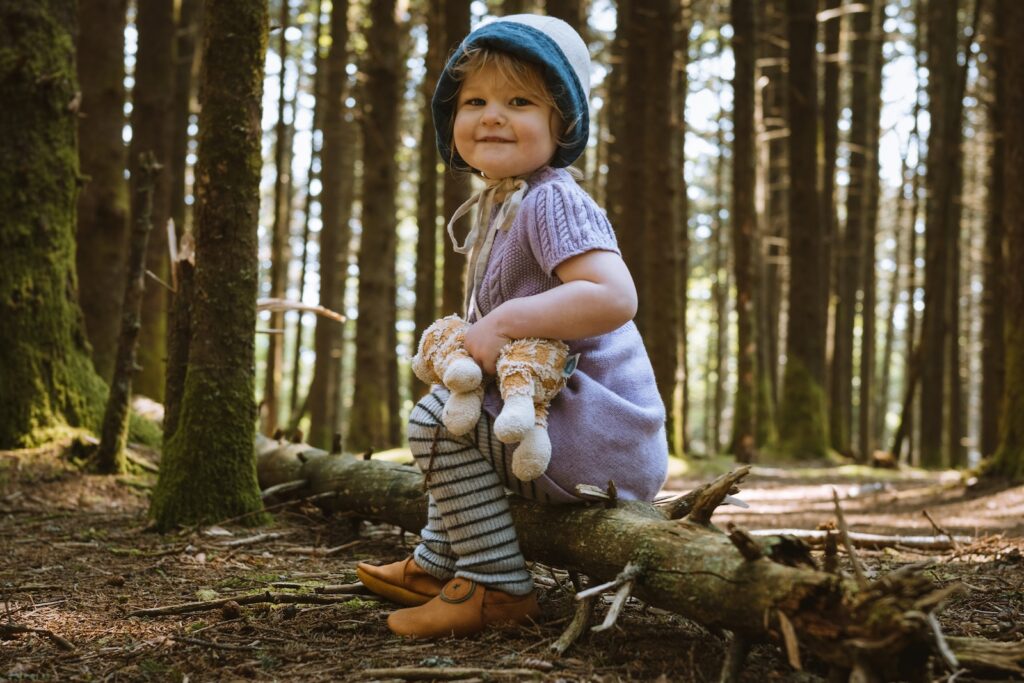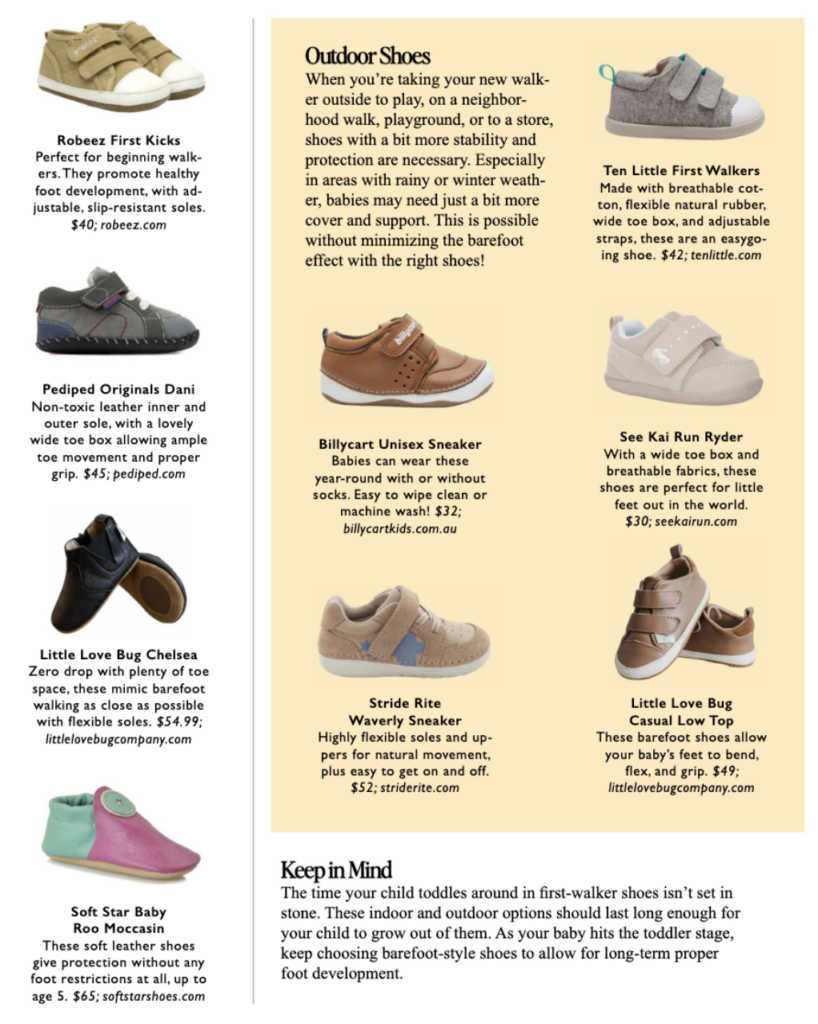Choosing Baby’s First Shoes
When it comes time for your baby’s first pair of shoes, you might feel lost in analysis paralysis because so many options are available. If you keep these barefoot principles in mind as you shop, you’ll get your babe started on the right foot!

Barefoot is best. There are several developmental benefits to going barefoot:
- Feet develop properly when they’re not restricted or bound.
- Going barefoot strengthens the feet and helps muscles develop better.
- Walking barefoot improves balance.
- Less time in shoes can improve blood flow.
Foregoing shoes at home and when the weather is ideal… but sometimes your baby needs to wear shoes. So, these barefoot principles for shoes can help you get your babe started on the right foot.
When Does Baby Need Shoes?
As your baby starts pulling to stand, cruising along furniture, and walking, their first pair of shoes is on the horizon. There’s no exact age to buy shoes. Rather, it depends on their developmental stage and your family’s lifestyle.
Some shoes are “first walkers” and are closest to barefoot with soft leather soles. Other shoes have flexible rubber soles that are more protective for outside and weather wear.
If you’re an on-the-go family or if your baby is the youngest and learning to walk at sibling’s soccer games, at the library, at the grocery store, etc… then sooner rather than later is the right choice for some foot protection.
However, if your baby is at home most of the time, it’s okay to wait until they are out in the world when safety and climbing support require shoes. Use your instincts and your baby’s lifestyle to decide when and what kind of shoes they need and best suit their lifestyle.
What to Look For
When shopping for your baby’s first shoes, there are a few things to keep in mind to help their natural development. Here’s what qualities to look for and why:
- Soft or flexible soles: A flexible sole allows the natural movement of a baby’s feet and gives them the sensory feedback necessary for paving the pathways in their brain. It’s lightweight and lets the baby’s feet feel the ground beneath them, reducing falls and helping their muscles develop.
- Wide toe box: The widest part of a baby’s foot is the toe area, not the ball of the foot. A wide toe box allows for natural toe splay and grip to help build muscles for balance and whole-body alignment.
- Flat insoles: For a baby’s foot to develop naturally, no arch support is best to mimic barefoot walking. Babies don’t need arch support, unless there is a medical reason.
- Zero drop: The bottom sole should be flat, and not built up in any way to allow proper foot strike and development of muscles without soles getting in the way.
- Easy on and off: Squirming babies and fiercely independent toddlers require choosing your battles and keeping the shoes easy to use. Plus, flexibility in fastening is a good idea to fit different foot shapes and sizes.
- Washability: First walker shoes can run into a whole lot of messes between mud, spills, markers, and who knows what else. A washable shoe is a major plus!
What to Avoid
While there are popular trends that come and go, there are some shoe trends that are best to skip. Here are a few things to avoid when looking for a baby’s first shoes:
- Stiff or narrow shoes that impede foot movement.
- Thick, inflexible, built up, or uneven soles.
- Excessive traction.
- Unnecessary arch support.
- Exposed toes.
Home or Indoor Shoes
For warmth at home, daycare, or in home-like environments when baby’s feet need covering, I recommend soft shoes with soft leather soles that completely allow barefoot-like walking.

Soft Star Baby Roo Moccasins are soft leather shoes that give protection without any foot restrictions at all. These moccasins cost more than some of the others, but what I love about them is they come in wide sizes and go up to age 5.
Robeez Soft Sole are perfect for barefoot-style walking with minimalistic ideals. They come in a range of sizes and tons of cute styles.
Robeez First Kicks have soft soles and are perfect for beginning walkers. They promote healthy foot development, with adjustable soles. They are slip resistant without having too much grip.
Pediped Originals Dani shoes have a non-toxic leather inner and outer sole, with a lovely wide toe box allowing ample toe movement and proper grip.
Little Love Bug Chelsea boots are adorable and minimalist, made with premium leather uppers and soles. They’re zero drop with plenty of toe space, these mimic barefoot walking as close as possible with flexible soles.
Outdoors or Out And About
When you’re taking your new walker outside to play, on a neighborhood walk, playground, or to a store, shoes with a bit more stability and protection are necessary. Especially in areas with rainy or winter weather, babe may need just a bit more cover and support.
This is possible without minimizing the barefoot effect with the right shoes!
Ten Little First Walkers are made with breathable cotton, and have great toe room with a wide toe box. The soles are made with flexible natural rubber, and they have adjustable velcro straps with a wide opening for an easy on-and-off process.
Billycart Unisex Sneaker fit regular, wide, and high feet with several color options. Baby can wear these year-round with or without socks. They have super flexible yet protective soles and uppers and have plenty of width in the toe box. They are easy to wipe clean or machine wash.
See Kai Run Ryder first walker shoes are lightweight and super flexible. They are made with recycled materials and are vegan to boot! With a wide toe box and breathable fabrics, these shoes are perfect for little feet out in the world. Added plus: They’re machine washable.
Stride Rite Waverly Sneakers have elastic laces and rounded soles for toe room. As a brand, Stride Rite is hit-and-miss for natural foot development. This style checks enough boxes that we are looking for. Its soles and uppers are highly flexible for natural movement, they are easy to get on and off, and wash easily with a wet cloth.
Little Love Bug Casual Low Top are barefoot shoes with great protective qualities. They allow your baby’s feet to bend, flex, and grip as they naturally would. They’re flexible, wide, and have zero drop outsoles. Plus, they’re super cute!
What’s Next?
The time your child toddles around in first-walker shoes isn’t set in stone. These indoor and outdoor options should last long enough for your kiddo to grow out of them. Be sure to keep your toddler in barefoot-style shoes as long as possible and just sizing them up as they grow.
Once they’re in big kid sizes, there are even more options to keep their feet protected in a natural way. Most of these basic principles work for bigger sizes as babies grow. And always allow for plenty of time walking barefoot outside. Connecting kids with nature leads to better physical health and more positive mental health outcomes.
